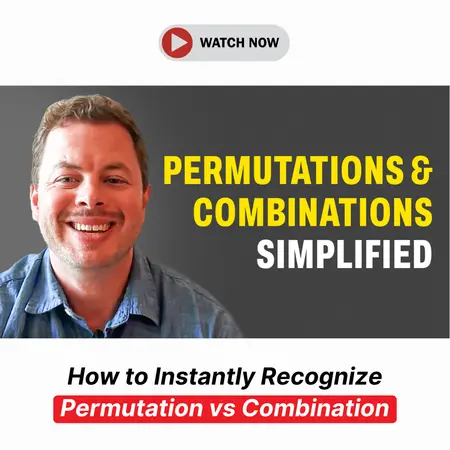Events & Promotions
|
|

GMAT Club Daily Prep
Thank you for using the timer - this advanced tool can estimate your performance and suggest more practice questions. We have subscribed you to Daily Prep Questions via email.
Customized
for You
Track
Your Progress
Practice
Pays
Not interested in getting valuable practice questions and articles delivered to your email? No problem, unsubscribe here.
- Nov 20
07:30 AM PST
-08:30 AM PST
Learn what truly sets the UC Riverside MBA apart and how it helps in your professional growth - Nov 20
01:30 PM EST
-02:30 PM IST
Learn how Kamakshi achieved a GMAT 675 with an impressive 96th %ile in Data Insights. Discover the unique methods and exam strategies that helped her excel in DI along with other sections for a balanced and high score. - Nov 22
06:30 AM PST
-08:30 AM PST
Let’s dive deep into advanced CR to ace GMAT Focus! Join this webinar to unlock the secrets to conquering Boldface and Paradox questions with expert insights and strategies. Elevate your skills and boost your GMAT Verbal Score now! - Nov 22
11:00 AM IST
-01:00 PM IST
Do RC/MSR passages scare you? e-GMAT is conducting a masterclass to help you learn – Learn effective reading strategies Tackle difficult RC & MSR with confidence Excel in timed test environment - Nov 23
11:00 AM IST
-01:00 PM IST
Attend this free GMAT Algebra Webinar and learn how to master the most challenging Inequalities and Absolute Value problems with ease. - Nov 24
07:00 PM PST
-08:00 PM PST
Full-length FE mock with insightful analytics, weakness diagnosis, and video explanations! - Nov 25
10:00 AM EST
-11:00 AM EST
Prefer video-based learning? The Target Test Prep OnDemand course is a one-of-a-kind video masterclass featuring 400 hours of lecture-style teaching by Scott Woodbury-Stewart, founder of Target Test Prep and one of the most accomplished GMAT instructors.
Kudos
Bookmarks
Suruchim12
The argument tells us that the amount and accuracy of info released has increased. So one would expect the accuracy of predictions based on info released to increase.
But we are told that the accuracy of predictions has not increased. So there is some force that is acting in the opposite direction. Option (E) says that the increased amount of info has made it difficult to manage all the info available. So with the new laws, though amount and accuracy of info has increased, manageability has decreased. That is the reason the accuracy of predictions based on this info has remained the same.
As for (D), all it says is that many sources are used for info. But if one source becomes more accurate, we would expect at least a little bit increase in the accuracy of predictions. We are not given that the accuracy of other sources reduces to keep the accuracy of predictions the same. Hence (D) is not correct.
GMATking94
Joined: 16 Jan 2022
Last visit: 18 Apr 2025
Posts: 180
Own Kudos:
Given Kudos: 125
Status:Do or Die
Location: India
Schools: IIMB '25 (A) IIMC '25 (A) IIMA '25 (D) ISB '25 (I)
GMAT 1: 700 Q48 V37

GPA: 4
WE:Operations (Energy)
Schools: IIMB '25 (A) IIMC '25 (A) IIMA '25 (D) ISB '25 (I)
GMAT 1: 700 Q48 V37

Posts: 180
Kudos:
75
Kudos
Bookmarks
generis
Hi Experts GMATNinja KarishmaB Bunuel fiftyoneverbal
I completely agree with the reason of (E) being the correct answer in comparison to (D) which is shaky in its reasoning. But is it not irrelevant with the question argument? What if there are more sophisticated methods available with the analysts to review the piece meal information? After all there should be some improvements in the analysts models when some info is inducted into that model...I think so...
I mean it puts more importance to the difficulty of processing that information.
I am not arguing with the answer provided in the official Q but want to know where did I go wrong in my thinking??
Thanks!
Kudos
Bookmarks
KarishmaB GMATNinja
I picked C because if the information about corporations was true even before the laws were passed, then it's likely that the predictions of the analysts have been inaccurate all along. This would also explain why the accuracy did not improve after the new laws.
E is much harder to justify because if increased info is making organization of info difficult, then the inaccuracy should have increased. But perhaps this is where the trap lies: given the conclusion does say that inaccurate info has not decreased, it could mean that it has either stayed the same or increased.
Nonetheless, if presented with a similar question, I'm not sure I'd be able to justify picking a choice such as E over C.
Quote:
I picked C because if the information about corporations was true even before the laws were passed, then it's likely that the predictions of the analysts have been inaccurate all along. This would also explain why the accuracy did not improve after the new laws.
Quote:
E is much harder to justify because if increased info is making organization of info difficult, then the inaccuracy should have increased. But perhaps this is where the trap lies: given the conclusion does say that inaccurate info has not decreased, it could mean that it has either stayed the same or increased.
Nonetheless, if presented with a similar question, I'm not sure I'd be able to justify picking a choice such as E over C.













